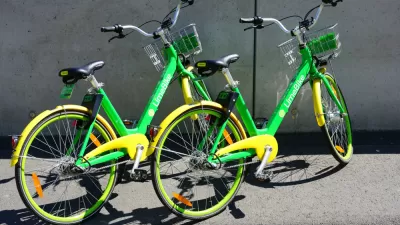Every so often, I read a blog post or an article talking about the trade-off between "mobility" and making places more accessible to nonmotorists. The hidden assumption behind such statements is that "mobility" means cars going as fast as possible. So if every street is an eight-lane highway with cars going 70 miles per hour, overall social "mobility" is therefore high.
Every so often, I read a blog post or an article talking about the trade-off between "mobility" and making places more accessible to nonmotorists. The hidden assumption behind such statements is that "mobility" means cars going as fast as possible. So if every street is an eight-lane highway with cars going 70 miles per hour, overall social "mobility" is therefore high.
The use of the word "mobility" to describe fast traffic slants public dialogue in favor of such traffic: after all, who could be against people being mobile?
But we need not define mobility this way. According to one online dictionary I found, "mobility" means (among other things) "the movement of people in a population, as from place to place."*
In a sprawling city where most streets are designed for fast traffic, the mobility of some people (fast drivers) is undoubtedly very high. But the mobility of others is not. In such places, streets are dangerous and uncomfortable for pedestrians- which means that in fact, nondrivers cannot easily move from place to place and are thus not so mobile after all. And even the mobility of drivers is limited: they can be mobile as long as they are driving, but if they choose not to drive for some reason, their mobility disappears.
Thus, government construction of wide, automobile-oriented streets does not create mobility for all. Instead, automobile-dependent places actually eliminate mobility for nondrivers. It logically follows that mobility for all is highest in places that accommodate pedestrians, transit users, and bicyclists as well as drivers- in other words, that accessibility is mobility.

Study: Maui’s Plan to Convert Vacation Rentals to Long-Term Housing Could Cause Nearly $1 Billion Economic Loss
The plan would reduce visitor accommodation by 25,% resulting in 1,900 jobs lost.

North Texas Transit Leaders Tout Benefits of TOD for Growing Region
At a summit focused on transit-oriented development, policymakers discussed how North Texas’ expanded light rail system can serve as a tool for economic growth.

Using Old Oil and Gas Wells for Green Energy Storage
Penn State researchers have found that repurposing abandoned oil and gas wells for geothermal-assisted compressed-air energy storage can boost efficiency, reduce environmental risks, and support clean energy and job transitions.

Private Donations Propel Early Restoration of Palisades Playground
Los Angeles has secured over $1.3 million in private funding to restore the Pacific Palisades playground months ahead of schedule, creating a modern, accessible space that supports community healing after recent wildfires.

From Blight to Benefit: Early Results From California’s Equitable Cleanup Program
The Equitable Community Revitalization Grant (ECRG) program is reshaping brownfield redevelopment by prioritizing projects in low-income and environmental justice communities, emphasizing equity, transparency, and community benefits.

Planting Relief: Tackling Las Vegas Heat One Tree at a Time
Nevada Plants, a Las Vegas-based nonprofit, is combating the city’s extreme urban heat by giving away trees to residents in underserved neighborhoods, promoting shade, sustainability, and community health.
Urban Design for Planners 1: Software Tools
This six-course series explores essential urban design concepts using open source software and equips planners with the tools they need to participate fully in the urban design process.
Planning for Universal Design
Learn the tools for implementing Universal Design in planning regulations.
Ascent Environmental
Borough of Carlisle
Institute for Housing and Urban Development Studies (IHS)
City of Grandview
Harvard GSD Executive Education
Toledo-Lucas County Plan Commissions
Salt Lake City
NYU Wagner Graduate School of Public Service






























